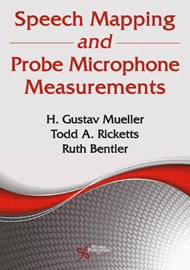Consisting of seven chapters, 300 pages, numerous graphs and images, alongside a host of ‘tips and tricks, ‘clinical concepts, and ‘points to ponder’, you will be hard-pressed to find a more detailed, thorough discussion of all things related to probe microphone measurements. This book is aimed at anyone who provides amplification, from student practitioners to experienced clinicians.
Until now, the only book dedicated to this procedure was a 1992 book titled Probe Microphone Measurements. Retaining one of the original three authors, this newly-titled revision is a welcome addition, and whilst following the format of the original text, the book leaps forward 25 years to the current state of knowledge and practice. Whilst primarily written for an American audience and, at times, feeling a little dated in the format and tone, this text is an essential read for anyone serious about providing amplification that is both effective and safe for the user.
The first two chapters provide background to the procedure which, whilst interesting, are not as essential reading as the following chapters. These detail very practically how to perform probe measures, including discussions on stimuli to use, loudspeaker set-up, calibration methods, test procedures and test environment. Open fittings are discussed in detail, alongside how to verify many of the features of modern DSP hearing devices (directionality, noise reduction, frequency lowering, feedback suppression, streaming) as well as more conventional features (CROS/BICROS). Speech mapping, as the title suggests, is covered in detail.
Two final chapters – ‘Putting it all together’ and ‘Frequently asked questions’ - provide a robust ending to the book, which cover many of the issues that arise when performing these crucial, but often overlooked, measurements. Yes, the book requires some time to read and digest, but the benefit to your practice will be worth it.




